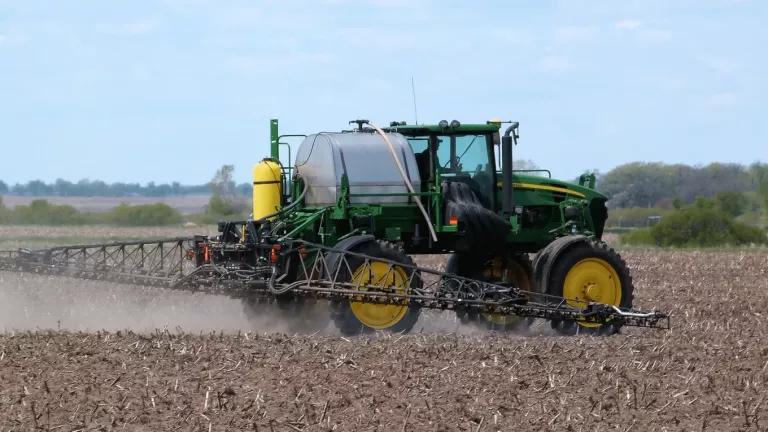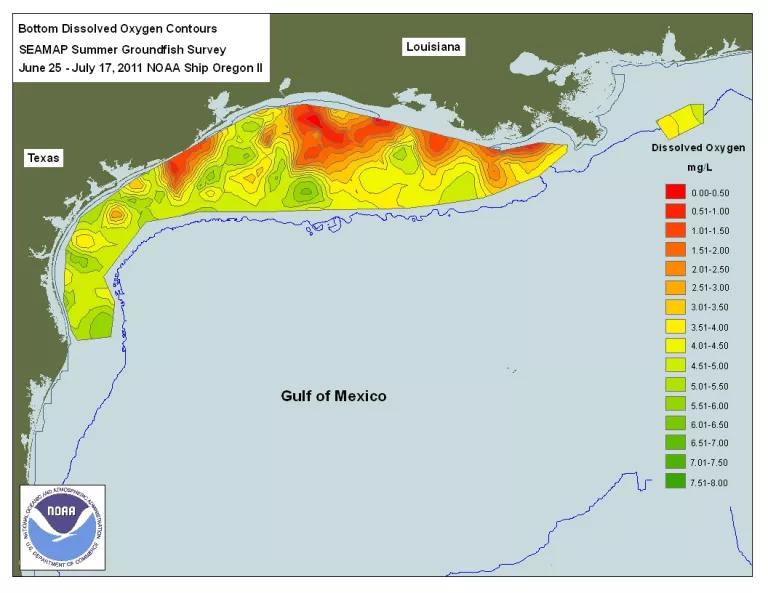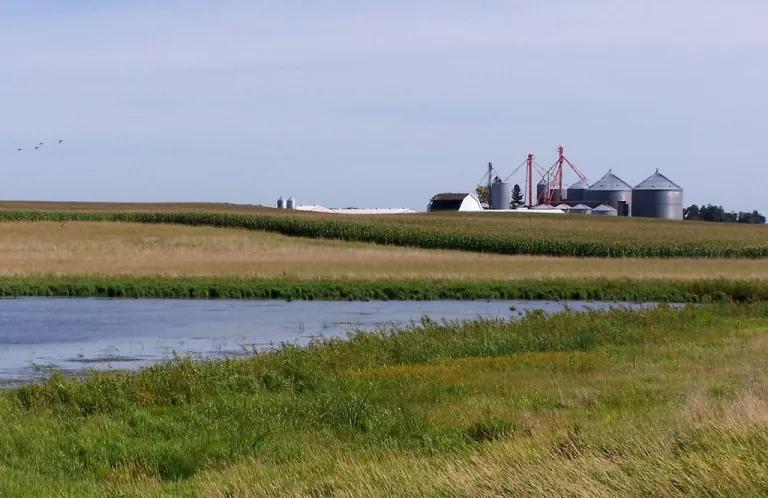Back from the Dead Zone
Doing just a little to curb fertilizer pollution in the Mississippi could go a long way to breathing life back into the Gulf.

Photo: Bill Meier
Every summer the fertilizer from corn and soybean farms along the Mississippi River drains from fields into rivers and streams. The nutrient-rich water flows south into the Gulf of Mexico and sits on top of the salty sea. There it feeds algae, which proliferate, die, and sink to the bottom. As the algae decompose, they use up much of the water’s oxygen, creating what we call a dead zone—where, as you might imagine, not much marine life (and the fishing industries that rely on them) can thrive.
Nitrogen alone accounts for 90 percent of the nutrients that leach into the Mississippi from the Corn Belt, a water-quality issue that has worsened as farmers use more commercial fertilizers and convert more land to crops. Despite efforts to cut back on how much fertilizer reaches the Gulf—mostly by limiting its use and planting cover crops like winter rye and clover to soak up nutrients—the 5,052-square-mile dead zone isn’t getting much smaller (it stubbornly remains the size of Connecticut).
According to research recently published in the Journal of the American Water Resources Association, however, that could change. If farmers take additional steps—like putting in wetlands, restoring the land around ditches and streams, and reconnecting rivers to floodplains—the researchers say they could reduce the amount of nitrogen washing into the Gulf and contract the dead zone to a fraction of what it is now.
Working together, these methods could even shrink the Gulf’s dead zone to 1,930 square miles, the goal the U.S. Environmental Protection Agency is trying to achieve by 2035 (the original deadline was 2015, oops). The agency currently requires each state to have a nutrient-reduction strategy and employ voluntary measures to limit nutrient runoff. But that strategy is not going too well.

One way the federal government encourages the ag community to take action is through the Conservation Reserve Program, which pays farmers to put (and keep) marginal land out of production and plant native plants that benefit the natural ecosystem. But high crop prices have made the program less attractive to farmers who would profit more from working the land. States have similar programs, but, unfortunately, not a lot of cash to put into them.
To reach the EPA’s goal in two decades, the total amount of nitrogen and phosphorus reaching the Gulf would have to drop by 45 percent. That sounds like a lot, but get this: The scientists say this goal can be met by implementing their methods on just 2.5 percent of the farmland in the northern watersheds that feed into the Mississippi River, and then converting an additional 1 percent of the land to wetlands.
“It’s not something that farmers need to be fearful of—it’s something they can participate in,” says study coauthor Mark Tomer, a soil scientist at the National Laboratory for Agriculture and the Environment. “It’s just a matter of recognizing that what we get out of an effort like this is probably greater in value than what we’re going to spend on it.”
That combination of wetlands, restored streams, better drainage ditches, and reconnected floodplains will be the key to reducing nutrients, says coauthor Jill Kostel, a senior environmental engineer for the Illinois-based Wetlands Initiative, a group that helps farmers install wetlands on their land.

This isn’t the first time scientists have looked into ways to limit nitrogen runoff. In 2006, William Crumpton, a wetland ecologist with Iowa State University, and his colleagues published a report for the U.S. Department of Agriculture stating that strategically placed wetlands on just 2 percent of farmland could cut the nutrient surplus by 30 percent all by themselves.
Iowa—which is the second-biggest nutrient contributor to the Gulf of Mexico (behind Illinois)—has begun to act on Crumpton's wetlands suggestion through the state’s Conservation Reserve Enhancement Program. The problem with these new wetlands so far, though, has been that they’re expensive to put in, and at a current 1,000 acres, there just aren’t enough of them.
“It’s not even remotely large enough,” says Crumpton. It would take hundreds of thousands of acres of wetlands to be successful. “The problem here is not a lack of technical solutions,” he says. “It’s the ability to implement them.”
Wetlands are a more permanent solution than cover crops or fertilizer cuts, which can change from year to year (especially when they are voluntary measures). Once a farmer or a water-management district installs a wetland, however, they’re less likely to take it out.
On that front, the Wetlands Initiative is working with farmers in Illinois to put in wetlands to demonstrate how well they can curb nutrient runoff. The first cattails, bull rushes, sedges, and prairie cord grass will go in this spring, and by summer, they’ll be capturing nitrogen that would have otherwise found its way to the Mississippi. Now, states, let’s talk about your ditches and floodplains…
This article was originally published on onEarth, which is no longer in publication. onEarth was founded in 1979 as the Amicus Journal, an independent magazine of thought and opinion on the environment. All opinions expressed are those of the authors and do not necessarily reflect the policies or positions of NRDC. This article is available for online republication by news media outlets or nonprofits under these conditions: The writer(s) must be credited with a byline; you must note prominently that the article was originally published by NRDC.org and link to the original; the article cannot be edited (beyond simple things such grammar); you can’t resell the article in any form or grant republishing rights to other outlets; you can’t republish our material wholesale or automatically—you need to select articles individually; you can’t republish the photos or graphics on our site without specific permission; you should drop us a note to let us know when you’ve used one of our articles.
In Planning for Climate Change, Native Americans Draw on the Past
Biodiversity 101
A Fearless Defender for Our Future
In Planning for Climate Change, Native Americans Draw on the Past
Biodiversity 101
A Fearless Defender for Our Future
In Planning for Climate Change, Native Americans Draw on the Past
Biodiversity 101
A Fearless Defender for Our Future
In Planning for Climate Change, Native Americans Draw on the Past
Biodiversity 101